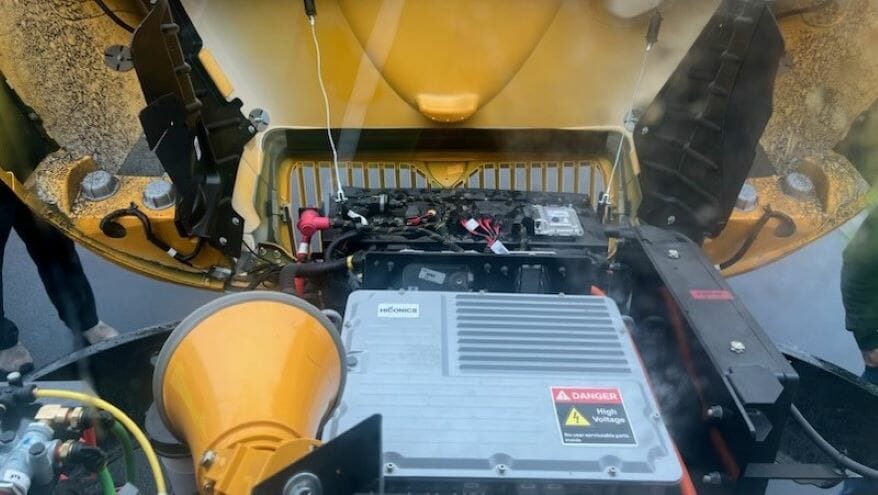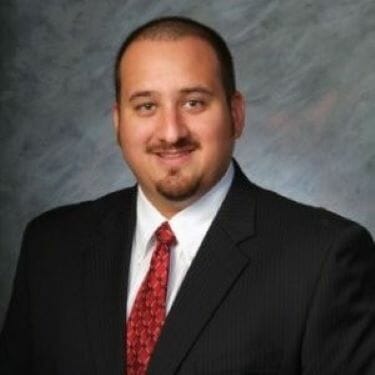Electric Vehicle Fleets are Coming on Fast Massive Electric School Bus Push by Feds
Published May 16th, 2023 at 6:00 AM
Above image credit: Blake Vargas and the head of Caney School District’s bus fleet recently traveled to the IC Bus assembly plant in Tulsa to see and test drive electric buses similar to the two they will take delivery on this summer. “They assemble top and bottom all in one plant,” he said. (Contributed)The electric vehicle revolution is being fought in some of the tiniest of hamlets in rural Kansas, bringing the battle to throttle climate change and achieve sustainability to unlikely locales.
Folks in Caney, Kansas, hard on the Kansas-Oklahoma border, with one of the smallest school districts you’ve never heard of, can’t wait until fall, when two spanking new electric school buses will fan out to gather students.
The annual fuel savings on those buses could pay a teacher’s salary for more than two months or a para-educator for longer, according to Blake Vargas, superintendent of the Caney Valley USD 436.
Evergy, the region’s big electric utility, is tossing out century-old business practices as it cozies up to customers in new ways to help them navigate the complexity of the changing electric grid. Its vast regional footprint overlies the former territories of Kansas City Power & Light and Kansas Gas & Electric, once based in Wichita and Topeka.
Evergy has ramped up its efforts to team up with school districts and large vehicular fleet operators in its 28,130-square-mile service territory as it transitions to electrified transport.
Evergy’s Region

Focus on Fleets
Gas powered cars, trucks and buses will become tomorrow’s horse-drawn buggy.
The utility is preparing for a massive surge of EV (Electric Vehicle) cars in the region. Yet it believes that the large fleets run by schools, cities, Amazon, UPS, FedEx, Hertz and others will provide the most dramatic cuts in carbon emissions when they are converted from fossil fuel power to electricity.
That is because these fleets are on the road many more hours each day than a commuting passenger or a mom or pop taking kids to soccer and sleepovers.
While the transition from gas-guzzlers to electrified cars will play out over decades, there is a very loud clock ticking when it comes to the 300 local school districts eager to apply for extremely attractive grants.
The window for application is narrow, with forms due to the feds by the end of August.
Caney last summer learned it had received a $790,00 federal grant to pay for two buses and charging infrastructure under a 2022 program. It qualified because the district is rural and has at least 20% of its students living in poverty under federal standards, Vargas said.
Next up, the U.S. Environmental Protection Agency is pushing out the door $5 billion in grants over the next five years to fund the purchase of electric school buses and supporting charging infrastructure.
Noting the urgency of the deadline, Evergy is hosting an online meeting the morning of May 23 for the “Evergy School Bus Electrification Consortium.”
It will cover: “Evergy EV charging rates for business, charger rebates” and — most significantly – “where to find more information about the Clean School Bus program and notice of funding just announced.”

Vargas said Evergy’s connected him and his team with Microgrid Labs to get detailed information about electric school buses, their energy use and savings and the budget and operational implications of switching over.
“When this opportunity presented itself, they (Evergy) wanted to be alongside us as a partner,” Vargas said. “What we built in the process is the ability to go full electric if we wanted to.”
Caney has 768 students and an existing fleet of 11 buses running eight routes a day picking up about half their student population, Vargas said.
The new round of competition for electric school bus grants will be stiff, he said. The district may seek more funding, hoping to get an edge from its experiences getting its first two buses.
Julie Dietrich, manager of Evergy’s fleet electrification, said: “My approach to this is to be a connector, to knock down barriers within Evergy so people get what they need. I’m getting busier and busier every day.”
“We work out of 40 service centers. As momentum builds, more and more people are exposed to this work,” she said of Evergy’s workforce realignment and new focus.
“What is great about our region is that other areas are five years ahead of us, and we can understand the possibilities and the pain points,” she said.
Other EV Opportunities
In addition to helping school districts, Dietrich said, the utility is interested in helping smaller businesses that lack the resources of large corporate fleet operators.
Bill George, who heads up WHC Worldwide, operator of zTrip, will deploy 20 Chevy Bolts on Kansas City streets by the end of May. Call it a pilot for its national operations, George said. zTrip is a cross between Uber or Lyft and a conventional taxi company with 3,000 vehicles around the country, including 400 in Kansas City.
George said that with Evergy’s guidance, he is putting out conventional Level 2 chargers on its property at 1300 Lydia Ave. in Kansas City.

His company is planning to install a dozen DC chargers near 14th and Virginia that can deliver 85% of an EV’s juice in 15-20 minutes for its own fleet. Those DC chargers will also be made available to electric vehicles in transit on nearby Interstate 70, George said.
Vargas, 40, said he has been to Tulsa to tour the IC Bus plant that will be making his buses, and he hopes to return this summer when his district’s buses are ready to pick up.
The acquisition is exciting in Caney, where the main employers are a plastic pipe and parts maker and the school district itself.
Vargas said on a test drive it took one of his drivers just a few minutes to adjust to the fast pickup of the bus, and the rapid braking that automatically occurs when the driver’s foot eases off the pedal.
Administrator Vargas, meanwhile, has visions of how much his district will be saving on brake repairs.
The buses will be quieter and that might motivate students to start their homework on the ride home, he mused. And the fuel savings might be used to install Wi-Fi service on the buses, he said.
“It’s a huge learning opportunity for us,” Vargas said.
Martin Rosenberg is a Kansas City journalist and host of the Grid Talk podcast on the future of energy.




